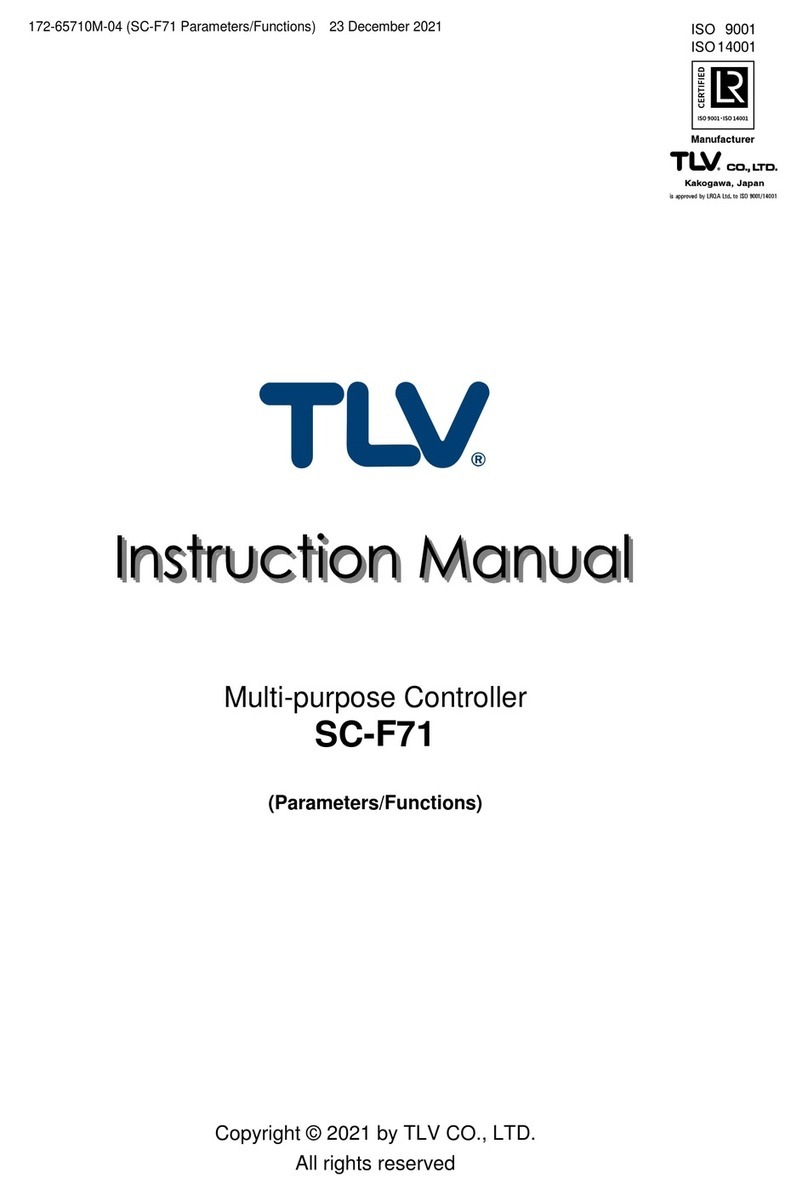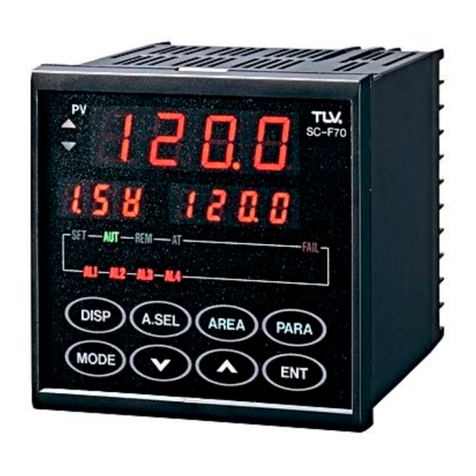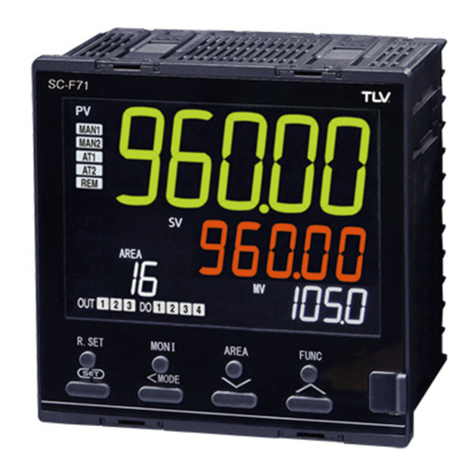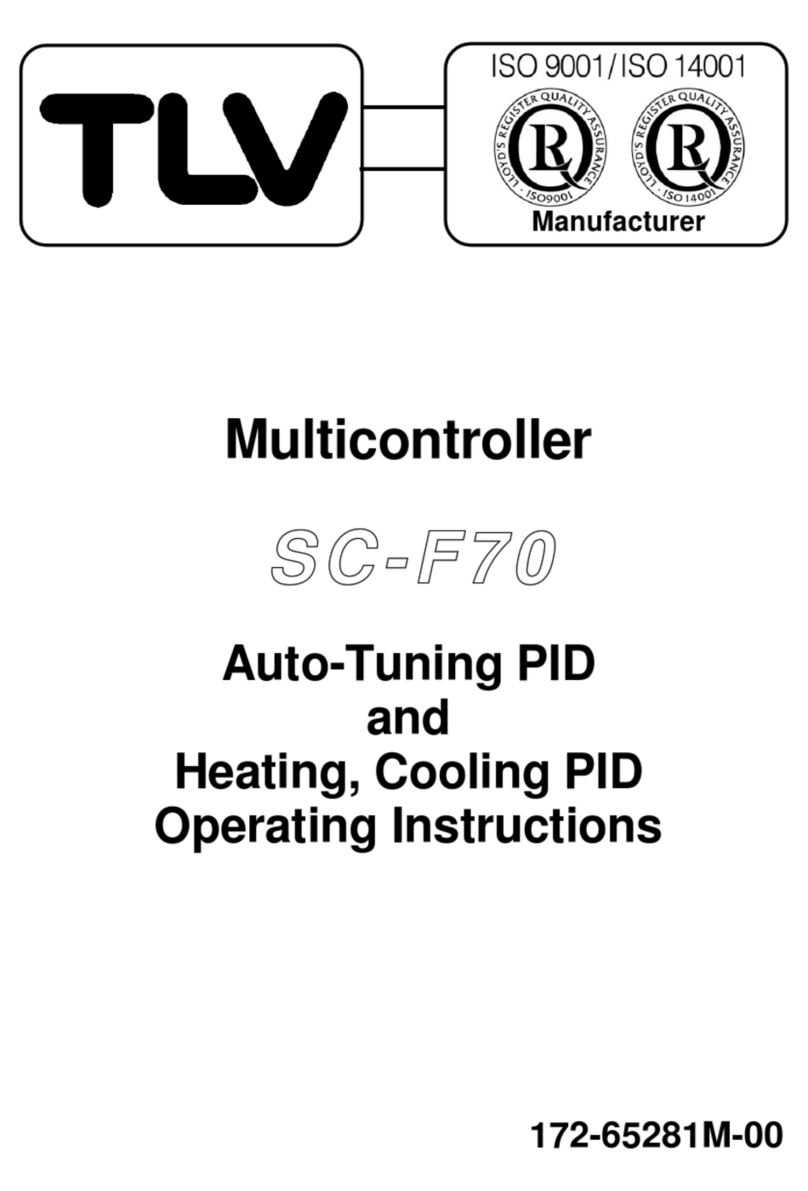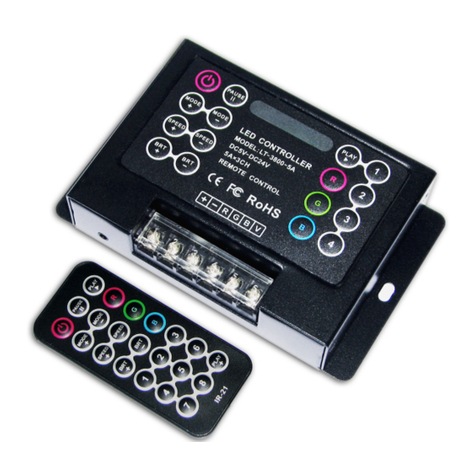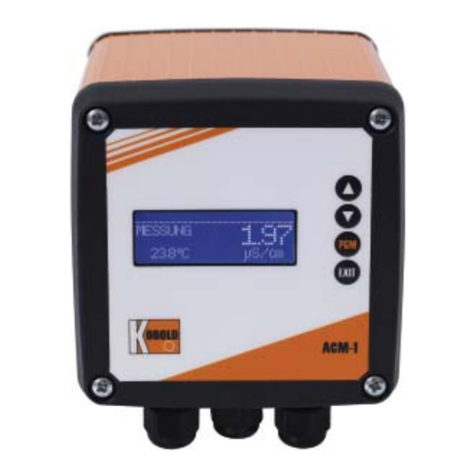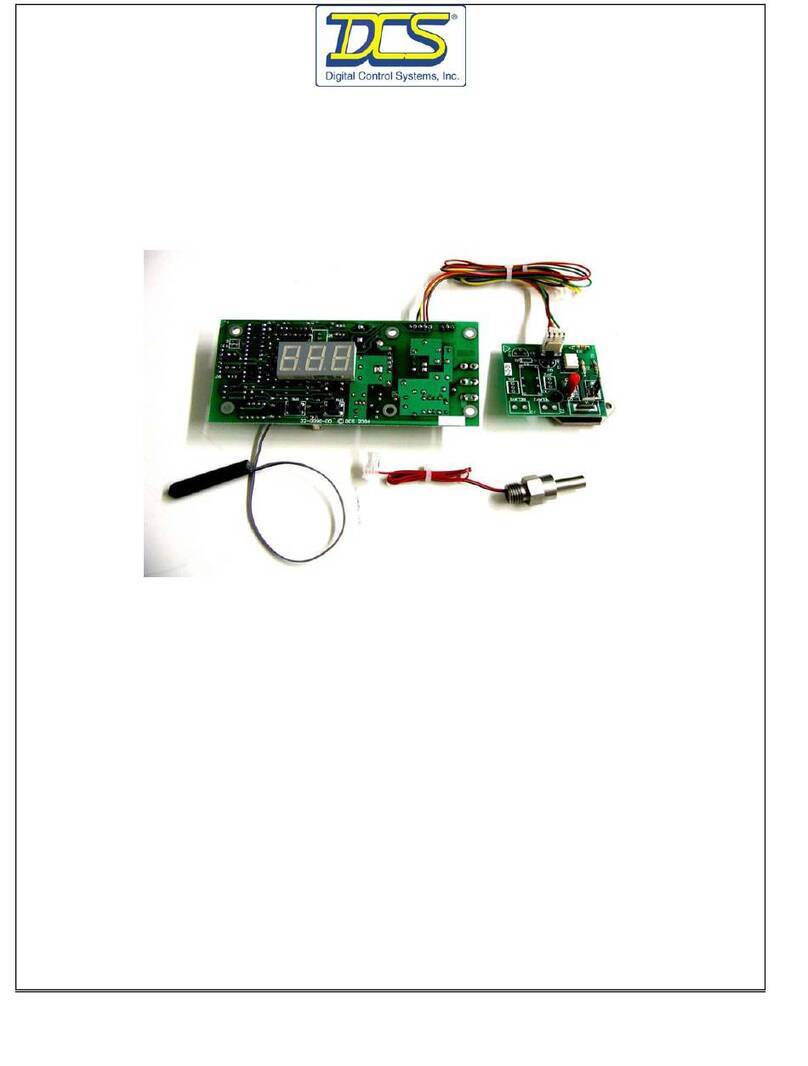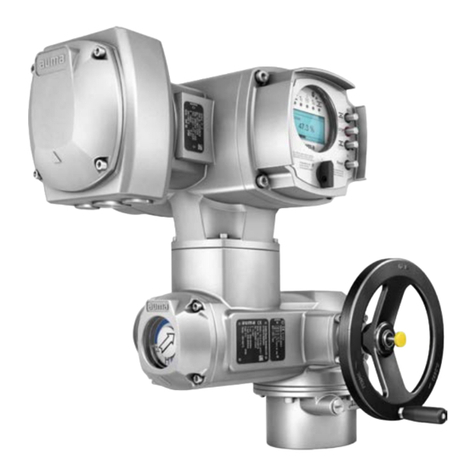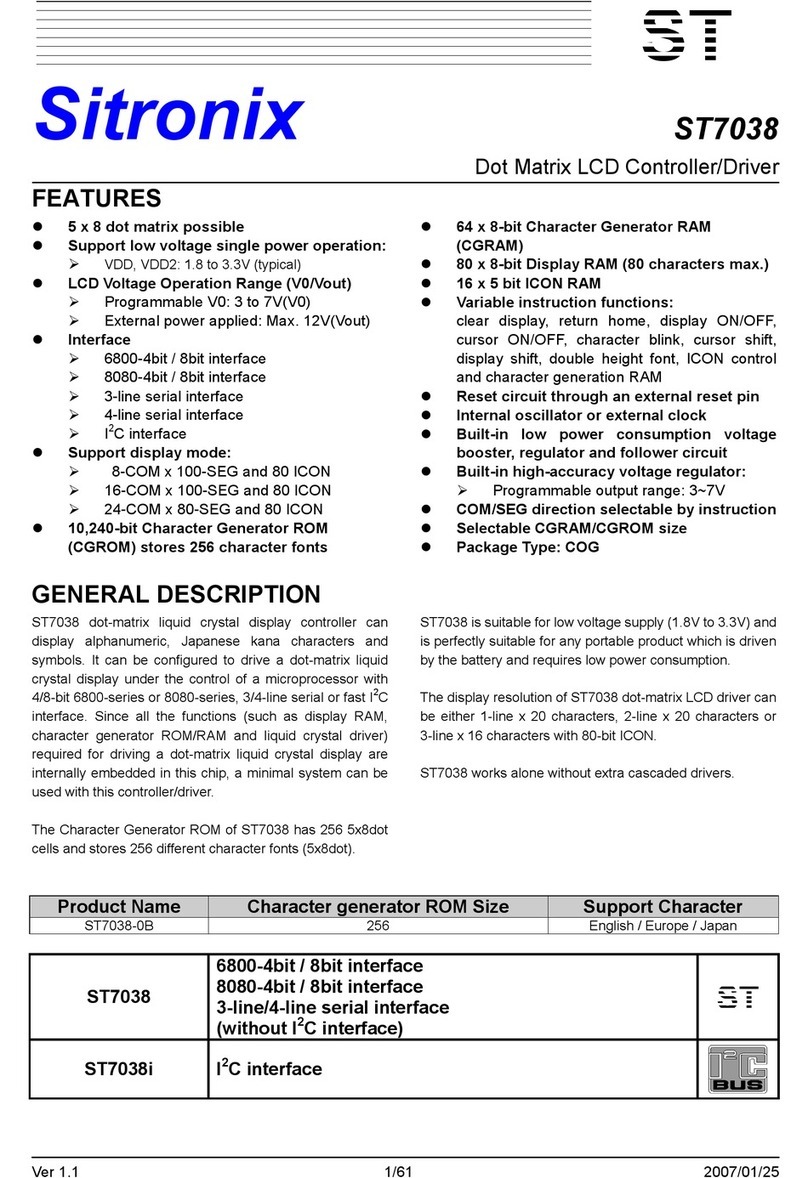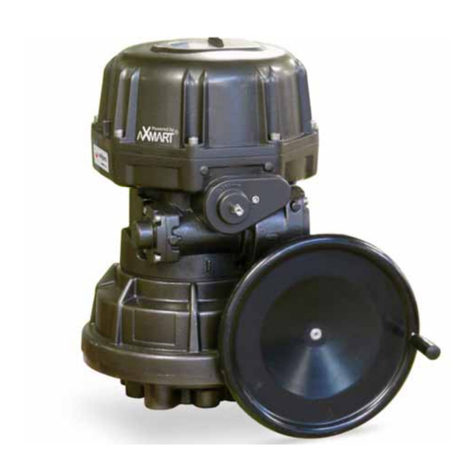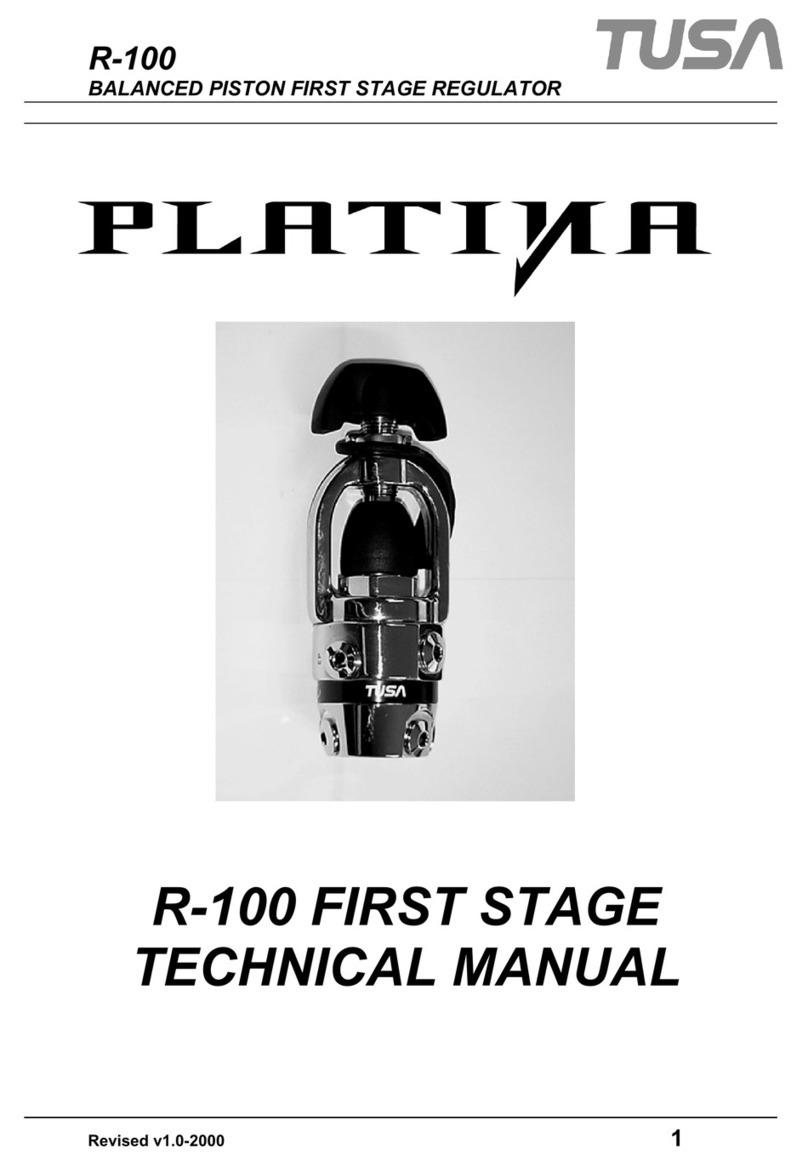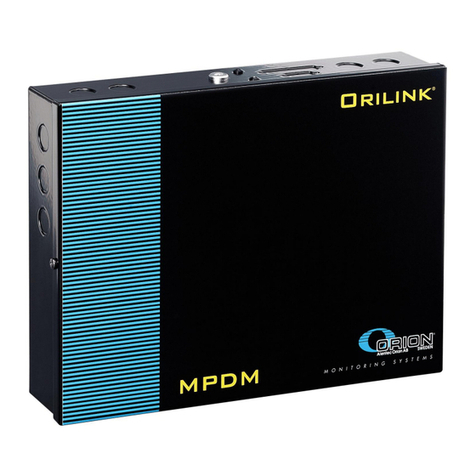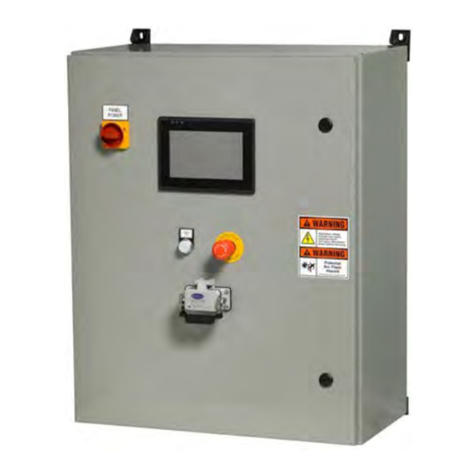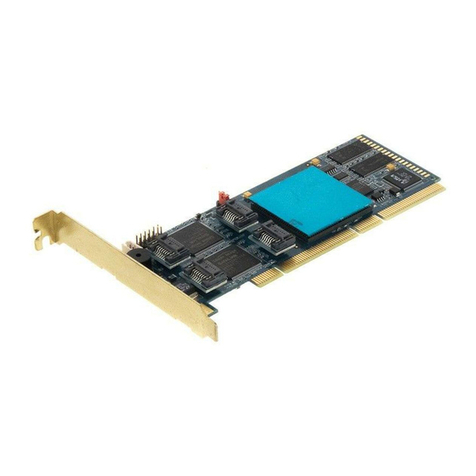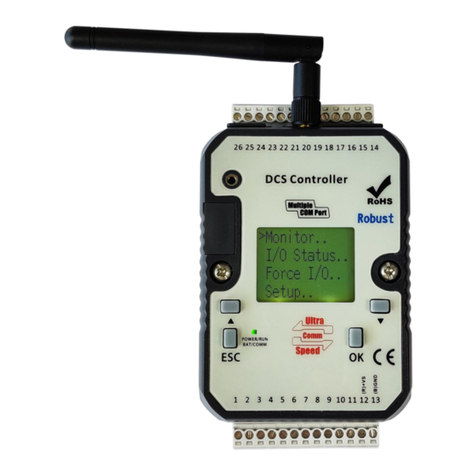TLV QuickTrap FX1 User manual

Copyright (C) 2023 by TLV CO., LTD. All rights reserved.
Deutsch
Français
English
UNIVERSAL TEMPERATURE CONTROL STEAM TRAP FX1
QuickTrap
FX1
Trap Unit
X1
INSTRUCTION MANUAL
Keep this manual in a safe place for future reference
TEMPERATUREINSTELLBARER KONDENSATABLEITER FX1
EINBAU- UND BETRIEBSANLEITUNG
Gebrauchsanleitung leicht zugänglich aufbewahren
PURGEUR RÉGULATEUR DE TEMPÉRATURE FX1
MANUEL D UTILISATION
Conserver ce manuel dans un endroit facile d'accès
Option
BD2
( )
F46+F32

Introduction
Before beginning installation or maintenance, please read this manual to ensure correct use of
the product. Keep the manual in a safe place for future reference.
The FX1 temperature control steam trap (connector body unit F46 or former connector unit F32*
and steam trap unit X1) with built-in scale removal function is suitable for the accurate control of
condensate discharge temperatures for applications with operating pressures up to 2.1 MPaG
(300 psig).
DO NOT USE on any application except steam tracing lines, storage tank coils and instrument
enclosures.
Note: The FX1 can only control the temperature of condensate discharge from the trap; it cannot
control product temperature nor the temperature of condensate backing up in the system.
* Configuration of F32 differs slightly from that of F46
1 MPa = 10.197 kg/cm2, 1 bar = 0.1 MPa
For products with special specifications or with options not included in this manual, contact TLV
for instructions.
The contents of this manual are subject to change without notice.
Einführung
Bitte lesen Sie die Betriebsanleitung vor Einbau und Inbetriebnahme sorgfältig durch und
bewahren Sie sie für späteren Gebrauch an einem leicht zugänglichen Ort auf.
Der temperatureinstellbare Kondensatableiter FX1 (bestehend aus Universal-Anschlussstück F46
bzw. älterem Universalanschlussstück F32* und Kondensatableiter X1) mit eingebauter Funktion
zur Entfernung von Ablagerungen und mit genau einstellbarer Kondensatablasstemperatur kann
für Anlagen mit Betriebsdrücken bis zu 21 bar ü eingesetzt werden.
NICHT BENUTZEN für beliebige Anwendungen außer für Begleitheizung, Behälterbeheizung und
Schaltschrankbeheizung.
Hinweis: FX1 Kondensatableiter regeln nur die Kondensatablasstemperatur, nicht aber die
Produkttemperatur oder die Temperatur von im System rückgestautem Kondensat.
* Formgebung von F32 weicht von F46 etwas ab
1 bar = 0,1 MPa
Wenden Sie sich an TLV für Sonderausführungen, die nicht in dieser Einbau-und
Betriebsanleitung enthalten sind.
Wir behalten uns vor, den Inhalt dieser Betriebsanleitung ohne Ankündigung zu ändern.
Introduction
Veuillez lire attentivement ce manuel afin de vous assurer d’utiliser correctement le produit. Nous
vous recommandons de le garder dans un endroit sûr pour de futures références.
Le purgeur régulateur de température FX1 (unité de raccord F46 ou la précédente F32* et purgeur
X1) avec mécanisme de nettoyage incorporé, convient pour la régulation précise des
températures d’expulsion du condensât, pour des applications avec une pression de
fonctionnement jusqu’à 21 bar.
UTILISER UNIQUEMENT pour les lignes de traçage à la vapeur, les réservoirs de stockage et le
chauffage d’instruments.
Note: Le FX1 régule uniquement la température du condensât expulsé du purgeur; il ne régule
pas la température du produit ni la température du condensât qui s’accumule dans le système.
* La construction de la F32 diffère légèrement de celle de la F46
1 bar = 0,1 MPa
Pour tout produit aux spécifications particulières ou comportant des options non reprises dans ce
manuel, veuillez contacter TLV.
Le contenu de ce manuel est sujet à modifications sans préavis.
Deutsch
Français
English
―1―

1. Safety Considerations
English
• Read this section carefully before use and be sure to follow the instructions.
• Installation, inspection, maintenance, repairs, disassembly, adjustment and valve
opening/closing should be carried out only by trained maintenance personnel.
• The precautions listed in this manual are designed to ensure safety and prevent equipment
damage and personal injury. For situations that may occur as a result of erroneous handling,
three different types of cautionary items are used to indicate the degree of urgency and the
scale of potential damage and danger: DANGER, WARNING and CAUTION.
• The three types of cautionary items above are very important for safety; be sure to observe
all of them, as they relate to installation, use, maintenance, and repair. Furthermore, TLV
accepts no responsibility for any accidents or damage occurring as a result of failure to
observe these precautions.
Indicates an urgent situation that poses a threat of death or serious injury.
Indicates a DANGER, WARNING or CAUTION item.
Indicates that there is a potential threat of death or serious injury.
WARNING
DANGER
CAUTION Indicates that there is a possibility of injury, or equipment/product
damage.
CAUTION
Install properly and DO NOT use this product outside the
recommended operating pressure, temperature and other specification
ranges. Improper use may result in such hazards as damage to the product
or malfunctions, which may lead to serious accidents. Local regulations
may restrict the use of this product to below the conditions quoted.
Take measures to prevent people from coming into direct contact
with product outlets. Failure to do so may result in burns or other injury
from the discharge of fluids.
Always wear heat-insulated gloves when handling products with high
body temperatures, such as when in operation. Failure to do so may
result in burns
.
The pressure and temperature values displayed on the nameplate of
the connector body are the values for the connector body itself and
not for the entire trap.
Improper use may result in such hazards as damage to the product or
malfunctions that may lead to serious accidents.
DO NOT disassemble or remove this product or use the scale
removal function while it is under pressure. Allow internal pressure of
this product to equal atmospheric pressure and its surface to cool to
room temperature before disassembling, removing or using the scale
removal feature. Failing to do so could cause burns or other injury.
Be sure to use only the recommended components when repairing
the product, and NEVER attempt to modify the product in any way.
Failure to observe these precautions may result in damage to the product
or burns or other injury due to malfunction or the discharge of fluids.
Use under conditions in which no water hammer will occur. The
impact of water hammer may damage the product, leading to fluid
discharge, which may cause burns or other injury.
Use only under conditions in which no freeze-up will occur. Freezing
may damage the product, leading to fluid discharge, which may cause
burns or other injury.
―2―

Deutsch
1. Sicherheitshinweise
•Bitte lesen Sie dieses Kapitel vor Beginn der Arbeiten sorgfältig durchund befolgen Sie die
Vorschriften.
•Einbau und Ausbau, Inspektion, Wartungs- und Reparaturarbeiten, Öffnen/Schließen von
Armaturen, Einstellung von Komponenten, dürfen nur von geschultem Wartungspersonal
vorgenommen werden.
•Die Sicherheitshinweise in dieser Einbau- und Betriebsanleitung dienen dazu, Unfälle,
Verletzungen, Betriebsstörungen und Beschädigungen der Anlagen zu vermeiden. Für
Gefahrensituationen, die durch falsches Handeln entstehen können, werden drei verschiedene
Warnzeichen benutzt: GEFAHR; WARNUNG; VORSICHT.
•Diese drei Warnzeichen sind wichtig für Ihre Sicherheit. Sie müssen unbedingt beachtet
werden, um den sicheren Gebrauch des Produktes zu gewährleisten und Einbau, Wartung und
Reparatur ohne Unfälle oder Schäden durchführen zu können. TLV haftet nicht für Unfälle oder
Schäden, die durch Nichtbeachtung dieser Sicherheitshinweise entstehen.
Dieses Zeichen weist auf GEFAHR, WARNUNG, VORSICHT hin.
VORSICHT
Die Einbauhinweise beachten und die spezifizierten Betriebsgrenzen
NICHT ÜBERSCHREITEN. Nichtbeachtung kann zu Betriebsstörungen
oder Unfällen führen. Lokale Vorschriften können zur Unterschreitung der
angegebenen Werte zwingen.
In sicherer Entfernung von Auslassöffnungen aufhalten und andere
Personen warnen, sich fernzuhalten. Nichtbeachtung kann zu
Verletzungen durch austretende Fluide führen.
Beim Umgang mit hohen Gehäusetemperaturen, wie sie während
des Betriebs auftreten, unbedingt hitzebeständige Handschuhe
benutzen. Nichtbeachtung kann zu Verbrennungen führen.
Das Produkt WEDER öffnen oder ausbauen, NOCH die
Reinigungsfunktion benutzen, solange es unter Druck steht. Vor
Öffnen des Gehäuses und Ausbau von Teilen warten, bis der Innendruck
sich auf Atmosphärendruck gesenkt hat, und das Gehäuse auf
Raumtemperatur abgekühlt ist. Nichtbeachtung kann zu Verbrennungen
oder anderen Verletzungen führen.
Zur Reparatur nur Original-Ersatzteile verwenden und NICHT
VERSUCHEN, das Produkt zu verändern. Nichtbeachtung kann zu
Beschädigungen führen, die Betriebsstörungen, Verbrennungen oder
andere Verletzungen durch austretende Fluide verursachen.
Die auf dem Typenschild des Universalanschlussstücks angezeigten
Druck- und Temperaturwerte beziehen sich nur auf das
Universalanschlusstück, nicht auf die gesamte Ableitereinheit.
Unsachgemäße Verwendung kann zu Betriebsstörungen führen, welche
Beschädigungen des Produkts oder schwere Unfälle zur Folge haben
können.
Nur an Stellen einbauen, an denen kein Wasserschlag eintreten
kann. Wasserschlag kann das Produkt beschädigen und zu
Verbrennungen oder Verletzungen durch austretende Fluide führen.
Nur in frostsicherer Umgebung einsetzen. Einfrieren kann das Produkt
beschädigen, was zu Verbrennungen oder Verletzungen durch
austretende Fluide führt.
bedeutet, dass eine unmittelbare Gefahr für Leib und Leben besteht.
bedeutet, dass die Möglichkeit der Gefahr für Leib und Leben besteht.
WARNUNG
GEFAHR
VORSICHT
bedeutet dass die Möglichkeit von Verletzungen oder Schäden an
Anlagen oder Produkten besteht.
―3―

1. Règles de sécurité
• Lire attentivement cette notice avant l’utilisation et suivre les instructions.
• Tout installation, inspection, entretien, réparation, démontage, ajustement et
ouverture/fermeture de vanne doit être fait uniquement par une personne formée à l’entretien.
• La liste des précautions à prendre est établie afin d’assurer votre sécurité et de prévenir des
dégâts matériels et/ou des blessures sérieuses. Dans certaines situations causées par une
mauvaise manipulation, trois indicateurs sont utilisés afin d’indiquer le degré d’urgence,
l‘échelle du dommage potentiel et le danger: DANGER, AVERTISSEMENT et ATTENTION.
• Ces 3 indicateurs sont importants pour votre sécurité; observez les précautions de sécurité
énumérées dans ce manuel pour l’installation, l’utilisation, l'entretien et la réparation du produit.
TLV ne prend aucune responsabilité en cas d’accident ou de dommage survenant à la suite
d'un non-respect de ces précautions.
Indique une situation d’urgence avec risque de mort ou de blessure grave.
Indique une situation pouvant entraîner la mort ou des blessures graves.
AVERTISSEMENT
DANGER
ATTENTION
Indique un risque de blessure ou de dégât matériel au produit et/ou aux
installations.
Indique un DANGER, un AVERTISSEMENT ou recommande une ATTENTION.
Français
ATTENTION
Installer le produit correctement et NE PAS l'utiliser en dehors de la
pression et de la température maximales de fonctionnement, ni en
dehors des autres plages spécifiées. Une telle utilisation peut entraîner
des dommages au produit ou des dysfonctionnements, ce qui peut
provoquer des brûlures ou autres blessures. Il se peut que des règlements
locaux limitent l'utilisation du produit en-deçà des spécifications indiquées.
Prendre les mesures appropriées afin d’éviter que des personnes
n’entrent en contact direct avec les ouvertures du produit. Le non-
respect de cette règle peut provoquer des brûlures ou autres blessures
sérieuses dues à l’écoulement des fluides.
Les valeurs de pression et de température inscrites sur la plaquette
apposée sur l'unité de raccord correspondent aux caractéristiques de
l'unité de raccord elle-même et non pas à celles du purgeur.
La mauvaise utilisation de ce produit pourrait entrainer certains risques
tels que des dommages au produit lui-même ou des défaillances menant
à des accidents graves.
Portez toujours des gants résistant à la chaleur lors du maniement
de produits présentant des températures de corps élevées,
notamment lorsqu'ils sont en fonctionnement. Le non-respect de
cette consigne peut être à l'origine de brûlures.
Ne pas démonter ni enlever le produit ou encore utiliser la fonction
de nettoyage du siège lorsque le purgeur est sous pression.
Avant
toute manipulation, s'assurer que le purgeur se dépressurise, de même que
la température du corps soit revenu à température ambiante. Dans le cas
contraire, vous pourriez vous exposer à des brûlures ou autres blessures.
En cas de réparation, utiliser uniquement les composants
spécifiques du produit et NE JAMAIS ESSAYER de modifier le
produit. Le non-respect de cette règle peut entraîner des dommages au
produit, ou des brûlures et autres blessures sérieuses dues au
dysfonctionnement du produit ou à l’écoulement des fluides.
N’utiliser que dans des conditions où le gel ne se produit pas. Le gel
peut endommager le produit et provoquer l’écoulement des fluides, et
causer des brûlures ou autres blessures sérieuses.
Utiliser le produit dans des conditions où il n’y a aucun coup de bélier.
L’impact d'un coup de bélier peut endommager le produit, et provoquer
l’écoulement des fluides, ainsi que des brûlures ou des blessures graves.
―4―

2. Configuration Aufbau Configuration
Replacement parts are available only
in the following kits:
M = Maintenance Parts
R = Repair Parts
T = Trap Unit
Ersatzteile werden nur in
folgenden Einheiten geliefert:
W = Wartungssatz
R = Reparatursatz
K = KA - Einheit
Pièces disponibles sous forme de
jeux uniquement:
E = Pièces d’entretien
R = Pièces de réparation
P = Unité de Purgeur
Description Bauteil Désignation
Trap Body
Cover
Valve Stem
Adjusting Screw
Bimetal Element
Washer
Valve Seat
Valve Seat Gasket
Overexpansion Spring
Return Spring
Snap Ring
Spring Pin
Seal Ring
Screen
Locknut
Cap Nut
Cover Gasket
Nameplate
(Trap Unit)
Spring Guide
Thrust Plate
Cap Nut Gasket
Connector Flange
Snap Ring
Outer Connector Gasket
Inner Connector Gasket
Connector Body
Screen
Screen Holder Gasket
Screen Holder
Connector Bolt
Flange
Nameplate
(Connector Unit)
Caution Plate A
Caution Plate B
Kondensatableiter-Gehäuse
Gehäusedeckel
Ventilstange
Justierschraube
Bimetallpaket
Zwischenscheibe
Ventilsitz
Ventilsitzdichtung
Überdehnsicherung
Rückholfeder
Spannring
Spreizstift
Dichtring
Schmutzsieb
Kontermutter
Kappe
Gehäusedichtung
Typenschild
(KA-Einheit)
Federführung
Stoßplatte
Kappendichtung
Anschlussflansch
Spannring
Äußere Dichtung
Innere Dichtung
Universal-Anschlussstück
Schmutzsieb
Stopfendichtung
Siebhaltestopfen
Halteschraube
Flansch
Typenschild
(Anschlussstück)
Warnschild A
Warnschild B
Corps du purgeur
Couvercle
Tige de soupape
Vis de réglage
Elément bimétallique
Rondelle
Siège de soupape
Joint de siège
Ressort de sur-dilatation
Ressort de rappel
Anneau tendeur
Goupille fendue
Anneau de scellement
Crépine
Contre-écrou
Ecrou à chapeau
Joint couvercle
Plaquette nominative
(Unité de purgeur)
Guide de ressort
Plaque d'appui
Joint écrou à chapeau
Bride de raccord
Anneau tendeur
Joint de raccord externe
Joint de raccord interne
Corps du raccord
Crépine
Joint de porte-crépine
Porte crépine
Boulon de raccord
Bride
Plaquette nominative
(Corps du raccord)
Plaquette de mise en garde A
Plaquette de mise en garde B
RMT RK RP
No.
1
2
3
4
5
6
7
8
9
10
11
12
13
14
15
16
17
18
19
20
21
22
23
24
25
26
27
28
29
30
31
32
A
B
Nr.
1
2
3
4
5
6
7
8
9
10
11
12
13
14
15
16
17
18
19
20
21
22
23
24
25
26
27
28
29
30
31
32
A
B
No.
1
2
3
4
5
6
7
8
9
10
11
12
13
14
15
16
17
18
19
20
21
22
23
24
25
26
27
28
29
30
31
32
A
B
WE
32
29
2826922
8
11
6
10
19
1
20
6
14
2
12
21
7
16 15 4 A 3 13 B17 18 23 24 25
27
5
30
31
Replacement parts for F32 differ from
those for F46. When you order
replacement parts, please include the
steam trap model name, size,
connection type and also the
connector unit name.
Ersatzteile für F32 entsprechen nicht
denen von F46. Bei Bestellung von
Ersatzteilen bitte unbedingt KA-Typ,
Größe, Anschlussart und Typ des
Universalanschlussstücks angeben.
Les pièces de rechange de l'unité de
raccord F32 diffèrent de celles de la
F46. Lorsque vous placez une
commande pour des pièces de
rechange, veuillez inclure le modèle du
purgeur, ses dimensions, le type de
raccordement et le modèle de l'unité
de raccord.
―5―
Deutsch
Français
English

3.
Exploded View Einzelteile Pièces détachées
CAUTION
VORSICHT
ATTENTION
DO NOT DISASSEMBLE OR REMOVE THIS
PRODUCT OR USE THE SCALE REMOVAL
FUNCTION WHILE IT IS UNDER PRESSURE.
Allow internal pressure of this product to equal
atmospheric pressure and its surface to cool
to room temperature before disassembling,
removing or using.
DAS PRODUKT WEDER ÖFFNEN ODER
AUSBAUEN, NOCH DIE
REINIGUNGSFUNKTION BENUTZEN,
SOLANGE ES UNTER DRUCK STEHT. Vor
Öffnen des Gehäuses und Ausbau von Teilen
warten, bis der Innendruck sich auf
Atmosphärendruck gesenkt hat, und das
Gehäuse auf Raumtemperatur abgekühlt ist.
Nichtbeachtung kann zu Verbrennungen oder
anderen Verletzungen führen.
NE PAS DEMONTER NI ENLEVER LE
PRODUIT OU ENCORE UTILISER LA
FONCTION DE NETTOYAGE DU SIEGE
LORSQUE LE PURGEUR EST SOUS
PRESSION. Avant toute manipulation,
s'assurer que le purgeur se dépressurise, de
même que la température du corps soit revenu
à température ambiante. Dans le cas contraire,
vous pourriez vous exposer à des brûlures ou
autres blessures.
13
12
16
21
24
30
27
28
29
26
25
22
15
17
20
10
11
19
14
2
3
6
6
9
7
8
5
4
32
18
Cover Unit / Deckeleinheit /
Jeu de couvercle
Valve Unit / Ventileinheit / Jeu de soupape
Cover Unit / Deckeleinheit /
Jeu de couvercle
Valve Unit / Ventileinheit /
Jeu de soupape
The X1 trap unit is designed for use with TLV
F46 and F32 connector units and TLV V1/V2 Series
trap stations. It is not compatible with TLV F46J
connector unit. The connector unit
name is indicated on the connector body.
Kondensatableitersatz X1 ist passend zu TLV
Anschlussstücken F46 und F32 und TLV
Verteilerstation V1/V2. Er passt nicht auf das
Anschlussstück TLV F46J. Die Typenbezeichnung
findet sich auf dem Anschlusssstück-Gehäuse.
L'unité du purgeur X1 est conçu pour être utilisé
avec les unités de raccord TLV F46 et F32 et les
stations de purge TLV V1/V2. Il n’est pas
compatible avec l’unité de raccord TLV F46J.
Le nom de l’unité de raccord est indiqué sur le
corps du raccord.
* Trap Unit X1
** Connector Body Unit
F46 or F32
* KA-Einheit X1
** Universal-Anschlussstück
F46 oder F32
* Unité de purgeur X1
** Corps du raccord
F46 ou F32
*
*
*
*
*
*
*
*
*
*
1*
* *
23
* **
**
**
**
**
*
*
*
*
*
*
*
*
*
*
*
*
*
Do not remove snap ring used to fix the flange.
Den Spannring, welcher den Flansch hält bitte
nicht entfernen.
Ne retirez pas l'anneau tendeur qui retient la
bride en place.
6
Deutsch
Français
English

Deutsch
Français
English
4. Specifications Technische Daten Données techniques
* Maximum allowable pressure (PMA) and maximum allowable temperature (TMA) are
PRESSURE SHELL DESIGN CONDITIONS, NOT OPERATING CONDITIONS.
** Valve No. is displayed for products with options. This item is omitted from the nameplate
when there are no options.
Refer to the product nameplate on the trap unit for detailed specifications.
A nameplate is also mounted on the F46 connector unit. The specifications displayed on the
nameplate are the values for the connector body itself. When a trap unit is installed, the
PMA/TMA and PMO/TMO are limited to the trap unit specifications.
Die technischen Daten stehen auf dem Typenschild.
Das Universalanschlussstück F46 ist ebenfalls mit einem Typenschild versehen. Die auf
diesem Typenschild angezeigten Daten beziehen sich auf das Universalanschlussstück. Bei
Anschluss eines Kondensatableiters sind PMA/TMA sowie PMO/TMO beschränkt auf die
Spezifikationen der Kondensatableitereinheit.
Les données techniques sont inscrites sur la plaquette nominative.
La plaque apposée sur l'unité de raccord F46 indique les caractéristiques techniques de
l'unité de raccord elle-même. Lorsque joint à un purgeur, les valeurs PMA/TMA/PMO/TMO
de l'unité de raccord se limitent à celles du purgeur.
Connector Unit (mounted only on F46)
Universalanschlussstück (nur auf F46 montiert)
Unité de raccord (apposé sur F46 uniquement)
* Maximal zulässiger Druck (PMA) und maximal zulässige Temperatur (TMA) sind
AUSLEGUNGSDATEN NICHT BETRIEBSDATEN.
** Die Valve No. wird angegeben bei Typen mit Optionen. Bei Typen ohne Optionen bleibt diese
Stelle frei.
* Pression maximale admissible (PMA) et température maximale admissible (TMA) sont les
CONDITIONS DE CALCUL DU CORPS, PAS LES CONDITIONS DE FONCTIONNEMENT.
** Le Valve No. est indiqué pour des modèles avec options. Ce numéro ne figure pas sur les
modèles sans options.
Die Einbauhinweise beachten und die spezifizierten Betriebsgrenzen
NICHT ÜBERSCHREITEN. Nichtbeachtung kann zu Betriebsstörungen
oder Unfällen führen. Lokale Vorschriften können zur Unterschreitung der
angegebenen Werte zwingen.
VORSICHT
Installer le produit correctement et NE PAS l’utiliser en dehors des plages
spécifiées. En cas de dépassement des limites données, des dysfonc-
tionnements ou accidents pourraient survenir. Il se peut que des
règlements locaux limitent l'utilisation du produit en-deçà des
spécifications indiquées.
ATTENTION
To avoid malfunctions, product damage, accidents or serious injury,
install properly and DO NOT use this product outside the specification
range. Local regulations may restrict the use of this product to below the
conditions quoted.
CAUTION
A: Model / Typ / Modèle
B: Nominal Diameter / Größe (DN) / Dimension (DN)
C: Max. Allowable Press.* / Max. zulässiger Druck* / Press. max. admissible*
D: Max. Allowable Temp.* / Max. zulässige Temp.* / Temp. max. admissible* (TMA)
E: Max. Operating Press. / Max. Betriebsdruck / Press. max. de fonctionnement
F: Max. Operating Temp. / Max. Betriebstemp. / Temp. max. de fonctionnement (TMO)
G
: Valve No.**
H: Serial No. / Serien Nr. / No. de série
A
D
H
CF
B
E
B
G
C
E
A
D
F
H
Trap Unit
KA - Einheit
Unité de purgeur
―7―

English
6. Proper Installation
• Installation, inspection, maintenance, repairs, disassembly, adjustment
and valve opening/closing should be carried out only by trained
maintenance personnel.
CAUTION
Note: For socket weld connections, use electric arc welding with a single pass. As internal
parts are not damaged by one pass welding, there is no need to remove them before welding.
1. In some instances, the trap unit and the connector body are sent as separate units. When
attaching them together, make sure the connector gaskets are still in place after having
removed their protective seal (See page 13 for details).
2. There are no restrictions on the installation direction beyond the following conditions:
a. The arrow on the connector body must point in the direction of condensate flow.
b. The connector body must be adjusted so that the connector flange face (for connecting
to the trap unit) is in the vertical plane.
c. The caution plates on the trap unit must face upward.
3. Before installation, be sure to remove all protective seals.
4. Before installing the trap, blow out the inlet piping to remove all dirt and oil.
5. Verify that piping is of a suitable diameter.
6. Support the pipes properly within 800 mm (2.5 ft) on either side of the trap.
7. Install in a place where caution plates (including cap) can clearly be seen during periods of
maintenance, in the lowest part of the pipeline so that condensate flows into the trap by
gravity.
8. Install inlet and outlet valves to isolate the product in event of trap failure or maintenance.
9. If the product is subject to back pressure, install a check valve.
10. Open the inlet valve gradually and make sure that the product functions properly.
• Take measures to prevent people from coming into direct contact with
product outlets.
• Install for use under conditions in which no freeze-up will occur.
• Install for use under conditions in which no water hammer will occur.
Installation Examples: Horizontal Piping
Correct
Caution plate is not facing upwards.
Universal Connector Flange is not
in the vertical plane.
Incorrect
Ground GroundGround GroundGround
5. Applications
• DO NOT USE on any application except steam tracing lines, storage tank coils and
instrument enclosures.
• SUITABLE for steam tracing lines or storage tank coils ONLY IF the required product
viscosity will be maintained when the condensate is sub-cooled at least 15 °C (27 °F), even to
the
point of the condensate having a lower temperature than the product temperature.
• SUITABLE for use on instrument enclosures ONLY IF the steam or condensate temperature
in the enclosures will NOT damage the instrument.
Caution
Plate
Connector
Flange
―8―

English
8. Adjusting Temperature Setting
• To prevent possible injury, always relieve pressure from trap before
opening to adjust the temperature setting.
• Always wear heat-insulated gloves and eye protection when handling pro-
ducts exposed to high temperatures. Failure to do so may result in burns.
CAUTION
The temperature setting can be easily adjusted.
7. Operational Check
A visual inspection can be carried out to aid in determining the necessity for immediate
maintenance or repair, if the trap is open to atmosphere. If the trap does not discharge to
atmosphere, use diagnostic equipment such as a stethoscope, thermometer or TLV TrapMan
(within its pressure and temperature measurement range).
(When conducting a visual inspection, flash steam is sometimes mistaken for steam leakage. For
this reason, the use of a steam trap diagnostic instrument such as TLV TrapMan is highly
recommended.)
Normal: Condensate is being discharged from the discharge outlet. (The surface temperature
of the trap should be about 10 to 20 °C (20 to 40 °F) lower than the set temperature.)
Blocked: No condensate is discharged and the surface temperature of the trap is low.
Blowing: Live steam continually flows from the outlet and there is a continuous hissing sound
of flow. The surface temperature of the trap is higher than the set temperature.
Instructions for Adjusting Temperature Setting
1. First close the external valve from which the steam and condensate flow to the trap (the
“inlet isolation valve”), followed by then closing the external valve to which the condensate
flows from the trap (the “outlet isolation valve”). Wait until the pressure between the inlet
isolation valve and the trap equals atmospheric pressure (when the trap body temperature
cools to room temperature). Do not remove the cap nut unless the trap is isolated from and
is not subjected to steam pressure.
2. Hold the cover with one wrench and use another wrench to slowly loosen and remove the
cap nut. Remove cap nut slowly to allow any residual pressurized steam to leak from the
trap interior through the threads of the adjustment screw and the cover.
3. Hold the adjusting screw in place with a flat-head screwdriver and remove the locknut
slowly in case of any additional steam leakage.
4. Use a flat-head screwdriver to turn the adjusting screw to adjust temperature. To raise the
temperature setting, turn the adjusting screw counterclockwise. To lower the temperature
setting, turn the adjusting screw clockwise. Refer to the set temperature adjustment chart
for the number of turns required from the "0" position to reach the desired temperature.
5. After completing the adjustment, replace the locknut. Hold the adjusting screw in place with
a flat-head screwdriver and tighten the locknut securely.
6. Replace the cap nut and tighten it to the proper torque (see page 13).
7. First fully open the outlet isolation valve, followed by then slowly opening the inlet isolation
valve – carefully checking for any steam leaks that might occur. In the event steam leaks are
detected, immediately close the inlet isolation valve, then the outlet isolation valve, and
repair the source of leakage.
8. Check the temperature setting by observing an inline temperature sensor or by measuring
the temperature at the wrench flat on the trap’s inlet side at least 30 minutes after supplying
steam with the new setting. The trap set temperature will be approximately 10 to 20 °C (20
to 40 °F) higher than the surface reading. If the resultant temperature is not as desired,
repeat procedure from step “1” above.
Caution
Plate
Connector
Flange
Installation Examples: Vertical Piping
Correct Incorrect
Caution plate is not facing upwards.
Ground Ground Ground
―9―

English
1. Start at the standard factory setting (point A) (100 °C at 0.9 MPaG, 9 barg; 212 °F at 130 psig).
2. Move up or down vertically to the desired set temperature (point B).
3. Follow the set temperature line in either direction to the vertical line corresponding to the
actual operating steam pressure (point C).
4. Follow the horizontal line to where it meets the left side of the chart (point D), indicating the
number and direction of turns required. (- turn: clockwise, + turn: counterclockwise)
Set Temperature Adjustment Chart
The trap can be set to open at any temperature between 50 °C and 200 °C (120 °F and 390 °F)
provided the set temperature is at least 15 °C (27 °F) below saturated steam temperature.
To determine the number and direction of adjusting screw turns required for the desired set
temperature, refer to the charts below.
-
turn: clockwise, + turn: counterclockwise
Standard "0" position = 100
˚
C at 0.9 MPaG, 9 barg; 212
˚
F at 130 psig
1 MPa = 10.197 kg/cm2= 10 bar
Adjusting
Screw
Adjuster Slot
Cover
A
B
Standard Factory Setting ("0" Position):
The standard "0" position is the position where point (A), the
bottom of the adjusting screw slot is even with point (B), the
top surface of the cap.
FX1
100 °C at 0.9 MPaG (9 barg),
212 °F at 130 psig
Temperature Setting Range
1 MPa = 10.197 kg/cm2= 10 bar
Set Temperature (˚F)
Operating pressure (psig)
Set Temperature (˚C)
Operating Pressure (MPaG)
0.20.1 0.3 0.5 0.7 1 2.1
200
150
100
50 15 20 30 50 100 200 300
390
300
200
120
15 ˚C below saturated
steam temperature
27 ˚F below saturated
steam temperature
Operating Pressure (psig)
Number of Turns of Adjusting Screw
Operating Pressure (MPaG)
Number of Turns of Adjusting Screw
Set Temperature (˚C)
Set Temperature (˚F)
200
190
180
170
160
150
140
130
120
110
100
90
80
70
60
50
0.20.1 0.3 0.5 0.7 1.512.1
B
A
C
DB
A
C
D
10 30 50 100 150 200 300
390
380
360
340
320
300
280
260
240
220
210
200
180
160
140
120
B
A
CD B
A
CD
-21/2
+21/2
+31/2
+41/2
-11/2
+11/2
-1/2
+1/2
-2
-1
+1
+2
+3
+4
+5
0
+
-
-21/2
+21/2
+31/2
+41/2
-11/2
+11/2
-1/2
+1/2
-2
-1
+1
+2
+3
+4
+5
0
+
-
―10―

English
9. Cleaning Function
Rust, scale and other buildup on the valve seat may hinder the sealing ability of the steam trap
and cause steam leakage and resultant higher product temperature; or block the valve seat
opening - thereby preventing condensate discharge and resultant lowered product temperature.
The FX1 contains a built-in cleaning device that can be used without removing the trap from the
line. Follow the steps below to remove contaminant accumulation from around the valve opening.
• To prevent possible injury, always relieve pressure from trap before
opening to clean the trap.
• Always wear heat-insulated gloves and eye protection when handling pro-
ducts exposed to high temperatures. Failure to do so may result in burns.
CAUTION
Cleaning Function Instructions
1. First close the inlet isolation valve, followed by then closing the outlet isolation valve. Wait
until the pressure between the inlet isolation valve and the trap equals atmospheric pressure
(when the trap body temperature cools to room temperature). Do not remove the cap nut or
the cover unless the trap is isolated from and is not subjected to steam pressure.
2. Hold the cover with one wrench and use another wrench to slowly loosen and remove the
cap nut. Remove cap nut slowly to allow any residual pressurized steam to leak from the trap
interior through the threads of the adjustment screw and the cover. If steam leakage occurs
while loosening cap nut or locknut, disassemble the trap and replace both the
seal ring and the cover gasket (see chapter 10).
3. Hold the adjusting screw in place with a flat-head screwdriver and remove the locknut slowly
in case of any additional steam leakage.
4. Check the current set position of the adjusting screw. Check and record the number of turns
required to return to the standard factory setting (when points (A) and (B) are even with each
other as shown on page 10).
5. Use a flat-head screwdriver to slowly turn the adjusting screw clockwise (to tighten) until it
stops. (This causes the cleaning edge of the stem to reach the valve seat and loosen debris).
6. Slowly turn the adjusting screw counterclockwise (to loosen) until it stops. (This will allow
flushing once the steam is safely turned on using the instructions that follow).
7. Replace the cap nut and tighten it to the proper torque (see page 13).
8. First fully open the outlet isolation valve, and then slowly and carefully open the inlet isolation
valve – checking for any steam leaks. In the event steam leaks are detected, immediately
close the inlet isolation valve, then the outlet isolation valve, and repair the source of leakage.
9. Wait 10 seconds to allow any loose scale to be flushed internally. Be aware of any external
steam leak – including the outlet connection if opened to atmosphere. Be careful to not come
in contact with any steam that is discharging from an open outlet connection. If any steam
leaks are detected elsewhere on the trap or piping, immediately close the inlet isolation valve,
then the outlet isolation valve, and repair the source of leakage.
10. Next, prepare to set the trap temperature again by first isolating the trap and safely relieving
all steam pressure from the trap as follows.
11. First close the inlet isolation valve, followed by then closing the outlet isolation valve. Wait
until the inlet pressure equals atmospheric pressure. (When the trap body temperature cools
to room temperature)
12. Hold the cover with one wrench and use another wrench to slowly remove the cap nut as in
step 2 above.
13. Slowly turn the adjusting screw clockwise (to tighten) to return to the original position
checked in step 4 above.
14. Replace the locknut. Hold the adjusting screw in place with a flat-head screwdriver and
tighten the locknut securely.
15. Replace the cap nut and tighten it to the proper torque (see page 13).
16. First fully open the outlet isolation valve, followed by then slowly opening the inlet isolation
valve – carefully checking for any steam leaks. In the event steam leaks are detected,
immediately close the inlet isolation valve, then the outlet isolation valve, and repair the
source of leakage.
17. Check the temperature setting by observing an inline temperature sensor or by measuring the
temperature at the trap inlet wrench flat at least 30 minutes after supplying steam with the
new setting. The trap set temperature will be approximately 10 to 20 °C (20 to 40 °F) higher
than the temperature reading on the trap body surface. If the resultant temperature is not as
desired, use the above instructions for adjusting temperature settings (see page 9).
―11―

Disassembly/Reassembly (to reassemble, follow procedures in reverse)
During Disassembly During Reassembly
Remove with a socket wrench Consult the table of tightening torques
and tighten to the proper torque
Remove and clean sealing
surfaces Replace with a new gasket if warped or
damaged
Remove with a spanner or socket
wrench Reattach and tighten
Remove with a spanner or socket
wrench Line up spring pin in valve stem with
grooves cut into the adjusting screw as
cover is placed onto the body; consult
the table of tightening torques and
tighten to the proper torque
Remove and clean sealing
surfaces Replace with a new gasket; coat
surfaces with anti-seize
Locknut 15
Cover 2
Cover Gasket 17
Screw in by using a flat-head
screwdriver Be careful not to damage the seal ring
during reassembly
Adjusting Screw 4
Remove
Replace with a new seal ring if damaged;
coat with heat resistant silicon grease
Seal Ring 13
Remove from the valve stem Reattach to the valve stemSnap Ring 11
Lift up and off from the valve stem Slide onto the valve stemWasher 6
Remove from the valve stem Place on the valve stemReturn Spring 10
Remove from the valve stem by
lifting up and off Slide onto the valve stemThrust Plate 20
Lift up and off from the valve stem Slide onto the valve stemWasher (5 sets) 6
Remove the bimetal element from
the valve stem by lifting up and off Reassemble the bimetal elements,
paying special attention to the proper
orientation (the TLV marks on the
outside, see Exploded View, p. 6)
Bimetal Element
(5 sets of 2 discs) 5
Cap Nut Gasket 21
Part & No.
Connector Bolt
See separate instruction 10.1 See separate instruction 10.1Connector Gaskets
English
Gasket(s)
Seal Ring
Valve Stem
Bimetal Element
Over-expansion and Return Springs
Check for warping and damage
Check for scratches and wear
Check for scratches and wear
Check for wear and deformation
Check for wear
Check for clogging, corrosion or damage
Check for rust, scale, oil film wear or damage
Check inside for rust and scale
Parts Inspection Procedure
Screen
Valve Seat
Body, Cover
Operational inspections should be performed at least twice per year, or as called for by trap
operating conditions. Steam trap failure may result in temperature drop in the equipment, poor
product quality or losses due to steam leakage.
10. Inspection and Maintenance
CAUTION
Continued on next page
• Installation, inspection, maintenance, repairs, disassembly, adjustment
and valve opening/closing should be carried out only by trained
maintenance personnel.
• Before attempting to open the trap, close the isolation valves and wait
until the trap has cooled completely. Failure to do so may result in burns.
• Be sure to use the proper components and NEVER attempt to modify the
product.
12

English
NOTE: - Coat all threaded portions with anti-seize.
- If drawings or other special documentation were supplied for the product, any torque
given there takes precedence over values shown here.
Tightening Torque and Distance Across Flats
Part Name & No.
Screen
Holder
(F32) 29
Screwed,
Socket Welded
Flanged
Cap Nut 16
Cover 2
Connector Bolt 30
Valve Seat 7
Screen Holder F46 (all connections and sizes) 29
15, 20 mm ( ”, ”)
25 mm ( 1”)
15 – 25 mm ( ” - 1”)
Torque
(lbf.ft)
(26)
(185)
(28)
(22)
(73)
(43)
(110)
(43)
N.m
35
250
39
30
100
60
150
60
1 N.m 10 kg・cm
〜
〜
Disassembly/Reassembly (to reassemble, follow procedures in reverse)
During Disassembly During ReassemblyPart & No.
Remove from the valve stem only
if damaged Replace with new if damagedSpring Pin 12
Remove without bending Reinsert without bendingScreen 14
Remove from the trap body Reinsert
Overexpansion Spring 9
Remove from the trap body Reinsert with proper orientationSpring Guide 19
Remove with a socket wrench,
being careful not to scratch the
sealing surfaces
Consult the table of tightening torques
and tighten to the proper torque; be
careful not to scratch seating surfaces
Valve Seat 7
Remove and clean sealing
surfaces Replace with a new gasket; coat
surfaces with anti-seize
Valve Seat Gasket 8
2
1
/
4
3
/
2
1
/
Distance Across Flats
mm
24
46
14
19
30
22
38
22
(in)
( )
(1 )
( )
( )
(1 )
( )
(1 )
( )
4
3
/
16
15
/
16
3
/
16
9
/
16
13
/
8
7
/
2
1
/
8
7
/
10.1 Separating/Attaching Trap and Connector Bodies
1. Loosen and remove the connector bolts, remove the entire trap unit from the connector body
and take it to a repair area where it can be supported in a vise during disassembly.
2. A When reinstalling the original trap:
a. Using a small screwdriver, remove the old gaskets from their housings in the trap body,
then clean the housings.
b. New connector gaskets must be installed.
c. To facilitate assembly and prevent loosening of the gaskets, apply a small amount of
suitable adhesive at 120˚ intervals around the outer edge of the gaskets.
d. Holding the trap body so that the gasket housings are horizontal, place the gaskets into
the housings.
2. B When installing a replacement trap:
a. Be sure to remove all protective seals, making sure the connector gaskets are still in place
after having removed their seal.
b. Before installation, scrape the mounting surface of the connector body clean using a soft
tool.
3. Align the bottom edge of the trap body with that of the connector body (see Fig. A), making
sure the gasket housings on the trap body align with the corresponding recesses in the
connector body. Maintaining the proper alignment, close the tops together until the two
faces are flush, making sure that connector gaskets remain in position.
4. Insert the connector bolts and finger-tighten, keeping
trap and connector bodies flush. Tighten the connector
bolts to the proper torque.
Figure A
Coat threads with anti-seize, then
tighten to the proper torque
Replace with a new gasket, apply anti-
seize to both surfaces
Insert without bending
Screen Holder
Gasket 28
Screens 14 & 27
Screen Holder 29
Remove without bending
Use a socket wrench to
remove
Remove the gasket and
clean the sealing surface
―13―

Instructions for Plug / Holder Disassembly and Reassembly
Gasket
Do not pinch gasket
in thread recesses
Coat with anti-seize
Gasket Surface
③
④
⑤
⑥
English
Replace with a new bimetal element
Correct the assembly of the bimetal
elements
Clean the bimetal elements
Use cleaning function
Clean parts
Readjust the screw
Use cleaning function
Replace with a new valve stem
Replace with a new valve seat
Tighten to the proper torque
Replace with a new gasket
Readjust the screw
Replace with a new gasket or seal
ring
Replace with a new seal ring
Replace with a new gasket
A bimetal element is damaged or broken
The assembly (orientation) of the bimetal
elements is incorrect
There is a build-up of foreign matter in the spaces
between the bimetal elements
The valve seat is clogged with rust and scale
The screen or piping are clogged with rust and scale
The adjusting screw is not correctly positioned
There is a build-up of dirt or scale on the valve
stem or seating surfaces of the valve seat
The valve stem is worn or sealing surfaces are damaged
The valve seat is worn or sealing surfaces are damaged
The valve seat is loose
The valve seat gasket is damaged
The adjusting screw is not correctly positioned
Leakage from the cap nut gasket: the gasket or
the seal ring is damaged or deteriorated
Leakage from the adjusting screw: the seal ring is
damaged or deteriorated
Leakage from the cover gasket: the cover gasket
is damaged or deteriorated
CauseProblem Remedy
No condensate
is discharged or
temperature
does not rise to
the set
temperature
Steam is blowing
or the
temperature
rises above the
set temperature
There is leakage
to the outside of
the trap
NOTE: When replacing parts with new, use the parts list on page 5 for reference, and replace with parts from
the Maintenance Kit and/or Repair Kit. Please note that replacement parts are only available as part
of a replacement parts kit.
The seal on the threaded plugs/holders found on TLV products is formed by a flat metal gasket.
There are various installation orientations for the gaskets, such as horizontal, diagonal and
downward, and the gasket may be pinched in the thread recesses during assembly.
Instructions for Disassembly and Reassembly
①Remove the plug/holder using a tool of the specified size
(distance across flats).
②The gasket should not be reused. Be sure to replace it with a
new gasket.
③Clean the gasket surfaces of the plug/holder and the product
body using a rag and/or cleaning agents, then check to
make sure the surfaces are not scratched or deformed.
④Coat both the gasket surface of the plug/holder and the
threads of the plug/holder with anti-seize, then press the
gasket onto the center of the gasket surface of the
plug/holder, making sure the anti-seize affixes the gasket
tightly to the plug/holder. Check to make sure the gasket is
not caught in the recesses of the threads.
⑤Hold the plug/holder upside down to make sure that the anti-
seize makes the gasket stick to the plug/holder even when
the plug/holder is held upside down.
⑥Screw the plug/holder by hand into the product body while
making sure that the gasket remains tightly affixed to the
center of the gasket surface of the plug/holder. Make sure
the entire gasket is making contact with the gasket surface
of the product body. It is important at this point to make sure
the gasket is not pinched in the thread recesses of the
plug/holder.
⑦Tighten the plug/holder to the proper torque.
⑧Next, begin the supply of steam and check to make sure
there is no leakage from the part just tightened. If there is leakage, immediately close the inlet valve
and, if there is a bypass valve, take the necessary steps to release any residual pressure. After the
surface of the product cools to room temperature, repeat the procedure beginning from step①.
11. Troubleshooting
If the expected performance is unachievable after installation of the steam trap, read chapters 5
and 6 again and check the following points to take appropriate corrective measures.
―14―

BD2 Valve
BD2
Valve Seat
(Screen
Holder)
F46
F32
Screwed & Socket Weld
25 mm (1")
All connections and sizes
Screwed & Socket Weld
Flanged 15 - 25 mm ( "-1")
2
1
/
15, 20 mm ( ", ")
2
1
/
4
3
/
②
①
①
②
(T): 30 N・m (22 lbf・ft)
(D): 17 mm
( ")
32
21
/
(T): 100 N・m (73 lbf・ft)
(D): 30 mm
(1 ")
16
3
/
(T): 60 N・m (43 lbf・ft)
(D): 22 mm
( ")
8
7
/
(T) : 150 N・m (110 lbf・ft)
(D) : 38 mm (2
")
8
1
/
12.2 Operation Instructions for BD2
The BD2 Blowdown Valve uses internal pressure to blow out condensate or steam (and scale/dirt
in the condensate or steam) from inside the unit to atmosphere.
Note: Do not leave the vicinity while the blowdown valve is in the open position.
CAUTION • Always wear eye protection and heat-resistant gloves when operating the
blowdown valve. Failure to do so may result in burns or other injury.
• When operating the blowdown valve, stand to the side well clear of the
outlet to avoid contact with internal fluids that will be discharged. Failure to do so may result in
burns or other injury.
• Do not use excessive force when opening the blowdown valve. Such force may break the pin
equipped as a valve stopper, causing a blowout from internal pressure resulting in burns or
other injury.
1. With two wrenches, firmly hold the BD2 Valve Seat (Screen Holder) ②(see table above for
distance across flats) in place while slowly opening the BD2 Valve ①(17 mm, "). Be
careful to avoid contact with fluid that will be discharged through the hole in the center of the
blowdown valve as the valve opens.
2. Close the BD2 Valve ①and tighten to a torque of 30 N·m (22 lbf·ft), and confirm that there is
no leakage. If leakage continues, dirt or scale may prevent the valve from sealing. Open and
blow out again, then try to close once more.
32
21
/
Torque (T) and Distance Across Flats (D)
BD2 Valve ①
Screen Holder Gasket
Discharge Hole
Valve Stopper Pin
BD2 Valve Seat
(Screen Holder)
Screen
②
12.1 Reassembly of Blowdown Valve
12. Optional Blowdown Valve BD2
Reassembly
• Installation, inspection, maintenance, repairs, disassembly, adjustment and valve
opening/closing should be carried out only by trained maintenance personnel.
CAUTION • When disassembling or removing the product, wait until the internal
pressure equals atmospheric pressure and the surface of the product
has cooled to room temperature.
1. Clean the trap, BD2 threads, and sealing surfaces, and apply a small amount of anti-seize.
2. Replace gasket.
3. Carefully place the gasket over the threaded portion, and position carefully so that it does not
become off-center.
4. Fasten to the steam trap with the proper torque.
BD2
Coat with
Anti-Seize
English
―15―

6. Einbauhinweise
ANMERKUNG: Bei Schweißmuffenanschluss Elektroschweißung mit einlagiger Schweißnaht an-
wenden. Die Innenteile brauchen dann wegen nur geringer Erw
ä
rmung nicht ausgebaut werden.
VORSICHT
1. Manchmal werden Universal-Anschlussstück und Kondensatableiter getrennt verschickt.
Dann ist darauf zu achten, dass nach Abnahme der Schutzkappe am Kondensatableiter die
Dichtringe noch sicher an ihrem Platz sitzen (siehe Seite 21).
2. Unter Berücksichtigung der folgenden Bedingungen kann das Universal-Anschlussstück in
jeder beliebigen Lage eingbaut werden:
a. Der Pfeil auf dem Anschlussstück muss in Durchflussrichtung zeigen,
b. Das Universal-Anschlussstück muss so eingebaut werden, dass die Flanschfläche zum
Anschluss des Kondensatableiters senkrecht steht.
c. Der Kondensatableiter muss mit dem Warnschild nach oben eingebaut werden
3. Vor dem Einbau die Transport-Schutzkappen entfernen.
4. Vor Einbau Leitung durchblasen, um Öl und Verschmutzungen zu entfernen.
5. Sicherstellen, dass die Leitungsnennweite ausreichend groß dimensioniert ist.
6. Die Kondensatleitung im Abstand von maximal 800 mm vor und hinter dem
Kondensatableiter abstützen.
7. FX1 so einbauen, dass alle Warnschilder (auch auf der Kappe) bei Wartung und Reparatur
gut sichtbar sind. Am niedrigsten Punkt der Rohrleitung einbauen, damit Kondensat gut
zufließen kann.
8. Falls die Auslassleitung in einen Tank oder eine Kondensatrückführleitung mündet, oder falls
mehrere Kondensatableiter an eine gemeinsame Leitung angeschlossen sind, muss ein
Rückschlagventil hinter jedem Kondensatableiter eingebaut werden.
9. Ein Rückschlagventil anbringen falls Gegendruck in der Produktleitung erwartet wird.
10. Einlassventil langsam öffnen und prüfen, ob FX1 richtig funktioniert.
Installationsbeispiele: horizontale Leitung
Richtig
Warnschild zeigt nicht nach oben
Kondensatableiter-Flanschfläche
steht nicht senkrecht
Falsch
Boden BodenBoden BodenBoden
• NICHT FÜR beliebige Zwecke einsetzen, außer für Begleitheizung und Behälterbeheizung,
Schaltschrankbeheizung.
• EINSETZBAR für Begleitheizung oder Behälterbeheizung NUR, FALLS die erforderliche
Produkt-Viskosität erhalten bleibt, wenn das Kondensat um mindestens 15 °C untergekühlt ist,
selbst wenn die Kondensat-Temperatur unter der Produkt-Temperaturliegt.
• EINSETZBAR in Schaltschränken NUR, FALLS die Dampfkondensat-Temperatur die
Instrumente in den Schränken NICHT beschädigen kann.
5. Anwendungen
•Einbau und Ausbau, Inspektion, Wartungs- und Reparaturarbeiten,
Öffnen/Schließen von Armaturen, Einstellung von Komponenten, dürfen
nur von geschultem Wartungspersonal vorgenommen werden.
• In sicherer Entfernung von Auslassöffnungen aufhalten und andere
Personen warnen, sich fern zu halten.
• Kondensatableiter nur dort einbauen, wo kein Wasserschlag eintreten
kann.
• Kondensatableiter in frostsicherer Umgebung einbauen.
Deutsch
Warn-
schild
KA-
Flansch
―16―

7. Funktionsprüfung
Falls der Kondensatableiter das Kondensat ins Freie abführt, können visuelle Inspektionen einen
Hinweis geben, ob sofortige Wartung oder Reparatur notwendig ist. An Kondensatrückführleitungen
angeschlossene Kondensatableiter können mit geeigneten Messgeräten, z. B. Stethoskop,
Thermometer oder TLV TrapMan (innerhalb ihrer Druck- und Temperaturmessbereiche) geprüft
werden.
(Bei visueller Inspektion wird oft Entspannungsdampf mit Dampfverlust verwechselt. Daher
wird empfohlen, im Zweifel Messgeräte, z. B. TLV TrapMan, zu verwenden.)
Normal: Kondensat wird kontinuierlich abgeleitet. Die Oberflächentemperatur des Kon-
densatableiters sollte 10 bis 20 °C unter der Kondensat-Ablasstemperatur liegen.
Blockiert: Kondensatabfluss ist nicht feststellbar und die Oberflächentemperatur des
Kondensatableiters ist niedrig.
Kondensat-
ableiter
bläst:
Dampf tritt kontinuierlich an der Auslassseite aus und ein pfeifendes Geräusch ist
hörbar. Die Oberflächentemperatur des Kondensatableiters ist höher als die
eingestellte Kondensat-Ablasstemperatur.
8. Einstellung der Kondensat-Ablasstemperatur
1. Zuerst das Ventil in der Dampf-und Kondensatzuführleitung schließen (das “Einlass-
Absperrventil”), danach das Ventil schließen, durch welches das Kondensat aus dem
Kondensatableiter abfließt (das “Auslass-Absperrventil”). Warten, bis der Druck zwischen dem
Einlass-Absperrventil und dem Kondensatableiter auf Atmosphärendruck abgesunken ist
(Wenn die Gehäusetemperatur des KA etwa Raumtemperatur beträgt). Die Kappe darf nicht
aufgeschraubt werden, solange das Einlassventil geöffnet ist und der Kondensatableiter unter
Dampfdruck steht.
2. Den Gehäusedeckel mit einem Schraubenschlüssel halten und die Kappe mit einem weiteren
Schraubenschlüssel abdrehen und abnehmen. Die Kappe langsam aufschrauben, um
möglicherweise noch im Gehäuse befindlichen Dampf durch das Gewinde zwischen Kappe
und Gehäuse abzulassen.
3. Die Justierschraube mit einem Schraubenzieher festhalten um die Temperatureinstellung
vorzunehmen. Die Kontermutter vorsichtig abdrehen, um noch eventuell vorhandenen Dampf
abzulassen.
4. Zur Temperatureinstellung mit einem Flachschraubenzieher die Justierschraube betätigen:
Zur Erhöhung der Temperatur entgegen dem Uhrzeigersinn, zur Verminderung der
Temperatur gemäß dem Uhrzeigersinn drehen. Das Temperatur-Einstelldiagramm gibt die für
Einstelltemperaturen erforderlichen Anzahlen an Umdrehungen der Justierschraube von der
“0”-Position aus an.
5. Nach Temperatureinstellung die Kontermutter aufsetzen und mit Schraubenschlüssel
festdrehen, dabei die Justierschraube mit Schraubenzieher festhalten.
6.
Kappe wieder aufsetzen und mit dem vorgesehenen Anzugsmoment festziehen (siehe Seite 21).
• Zur Vermeidung von möglichen Verletzungen immer den Druck ablassen,
bevor der KA zwecks Temperatureinstellung geöffnet wird.
• Beim Umgang mit hohen Temperaturen unbedingt hitzebeständige
Handschuhe und Augenschutzbrille benutzen. Nichtbeachtung kann zu
Verbrennungen führen.
Die Ablasstemperatur kann einfach wie folgt eingestellt werden.
VORSICHT
Anweisungen zur Temperatureinstellung
Warn-
schild
Installationsbeispiele: vertikale Leitung
Richtig Falsch
Warnschild zeigt nicht nach oben
Boden Boden Boden
Deutsch
KA-
Flansch
―17―

Standard Werkseinstellung ("0"-Stellung):
Die Standard "0"-Stellung ist gegeben, wenn
Schlitzende (A) auf einer Ebene mit der
Oberfläche (B) des Gehäusedeckels liegt.
FX1
100 °C bei 9 bar ü
Justier-
schraube
Justierschlitz
Gehäuse-
deckel
A
B
Temperatureinstellbereich
Einstelltemperatur (˚C)
Betriebsdruck (bar ü)
1 bar = 0,1 MPa
2135710 21
200
150
100
50
15 ˚C unter Sattdampf-
temperatur
1. Von der Standard Werkseinstellung Punkt A
ausgehen (100 °C bei 9 bar ü).
2. Von A senkrecht nach oben oder unten gehen bis
zur gewünschten Ablasstemperatur (Punkt B).
3. Von B aus der Temperaturlinie folgen (auf- oder
abwärts) bis zum Schnittpunkt mit dem
anstehenden Dampfdruck (Punkt C).
4. Von C horizontal auf die vertikale Achse des
Diagramms gehen und die Anzahl der
Umdrehungen der Einstellschraube ablesen
(Punkt D). (+ : gegen Uhrzeigersinn, - : im
Uhrzeigersinn).
Temperatur-Einstelldiagramm
Der Temperatureinstellbereich liegt zwischen 50 und 200 °C, die Einstelltemperatur muss
jedoch mindestens 15 °C unter der Sattdampftemperatur liegen. Die Anzahl der Umdrehungen
sowie die Drehrichtung zur Einstellung der Ablasstemperatur werden mit Hilfe der Diagramme
unten ermittelt.
Einstelltemperatur (˚C)
Betriebsdruck (bar ü)
Umdrehungen der Justierschraube
- : im Uhrzeigersinn + : gegen Uhrzeigersinn
Standard "0" Stellung = 100 °C bei 9 bar ü
200
190
180
170
160
150
140
130
120
110
100
90
80
70
60
50
213571510 21
B
A
C
DB
A
C
D
-21/2
+21/2
+31/2
+41/2
-11/2
+11/2
-1/2
+1/2
-2
-1
+1
+2
+3
+4
+5
0
+
-
7. Zuerst langsam das Auslassventil aufdrehen, dann das Einlassventil. Prüfen, ob
Dampfleckage auftritt. Falls Leckage beobachtet wird, sofort das Einlassventil schließen,
dann das Auslassventil und die Ursache der Leckage reparieren.
8. Die Temperatureinstellung entweder mit einem eingebauten Thermometer oder durch
Messung auf der flachen Oberseite am Einlass des Kondensatableiters nach Dampfeintritt
mindestens 30 Minuten lang beobachten. Je nach Wandstärke ist die lnnentemperatur
10 – 20
°C höher als die Oberflächentemperatur. Falls die gewählte Temperatur nicht
erreicht wird, den Vorgang ab Punkt 1, Seite 17, wiederholen.
Deutsch
―18―

Anweisungen zum Reinigungsvorgang
1. Zuerst Einlassventil, dann Auslassventil schließen. Warten, bis der Druck zwischen
Einlassventil und dem Kondensatableiter auf Atmosphärendruck abgesunken ist (wenn die
Oberflächentemperatur auf Raumtemperatur abgesunken ist). Die Kappe oder Konternummer
nicht öffnen, wenn die Absperrarmaturen noch offen und FX1 noch unter Druck steht.
2. Den Gehäusedeckel mit einem Schraubenschlüssel halten und mit einem anderen Schlüssel
die Kontermutter langsam lösen. Deckel und Mutter langsam lösen, damit noch vorhandener
Dampf unter Druck durch die Gewindegänge entweichen kann. Falls Dampfleckage auftritt,
FX1 öffnen und die Dichtungen auswechseln (siehe Kapitel 10).
3. Den Gehäusedeckel mit einem Schraubenschlüssel halten und die Kappe mit einem weiteren
Schraubenschlüssel abdrehen und abnehmen. Die Kontermutter vorsichtig abdrehen, um
noch eventuell vorhandenen Dampf abzulassen.
4. Die Position der Justierschraube und die Anzahl der Drehungen um zur Werkseinstellung zu
gelangen prüfen. (Wenn A und B den Stellungen auf Seite 18 entsprechen).
5. Mit flachem Schraubenzieher die Justierschraube langsam im Uhrzeigersinn drehen
(Schließrichtung) bis sie stoppt. (Dadurch wird die Reinigungskante in Richtung Ventilsitz
bewegt und damit Ablagerungen entfernt).
6. Die Justierschraube langsam gegen Uhrzeigersinn drehen (Öffnungsrichtung), bis sie stoppt.
(Das erlaubt die Reinigung nach Beginn der Dampfzufuhr).
7. Kappenmutter aufsetzen und auf vorgeschriebenes Drehmoment anziehen (siehe Seite 21).
8. Jetzt das Auslassventil voll öffnen, danach langsam und vorsichtig das Einlassventil. Dabei
auf möglichen Dampfverlust achten. Falls Leckage beobachtet wird, sofort das Einlassventil
schließen, dann das Auslassventil und die Ursache der Leckage reparieren.
9. 10 Sekunden warten, um Schmutz auszuschleusen. Auf eventuelle Dampfleckage achten –
einschliesslich an der ins Freie führenden Auslaufseite . Vorsicht vor austretendem Dampf
aus der offenen Auslassleitung. Falls an dem Kondensatableiter irgendwo Dampfleckage
beobachtet wird, sofort das Einlassventil, dann das Auslassventil schließen und den Schaden
reparieren.
10. Danach die Einstelltemperatur wieder einstellen. Zuerst FX1 vollständig absperren und den
Dampfdruck, wie folgt, reduzieren:
11. Zuerst Einlassventil schließen, dann Auslassventil. Warten bis der Dampfdruck dem
Umgebungsdruck entspricht (wenn die Oberflächentemperatur Raumtemperatur erreicht hat).
12. Den Gehäusedeckel mit einem Schraubenschlüssel halten und mit einem anderen Schlüssel
die Kontermutter langsam lösen (siehe Punkt 2 oben).
13. Langsam die Justierschraube im Uhrzeigersinn (Schließrichtung) drehen, um zu der unter
Punkt 4 beschriebenen Stellung zu gelangen.
14. Kontermutter aufsetzen. Die Justierschraube mit flachem Schraubenzieher festhalten und die
Kontermutter fest anziehen.
15. Kappenmutter aufsetzen und auf vorgeschriebenes Drehmoment anziehen (siehe Seite 21).
16. Jetzt das Auslassventil voll öffnen, danach langsam und vorsichtig das Einlassventil. Dabei
auf möglichen Dampfverlust achten. Falls Leckage beobachtet wird, sofort das Einlassventil
schließen, dann das Auslassventil und die Ursache der Leckage reparieren.
17. Die Temperatureinstellung entweder mit einem eingebauten Thermometer oder durch
Messung auf der flachen Oberseite am Einlass des Kondensatableiters nach Dampfeintritt
mindestens 30 Minuten lang beobachten. Je nach Wandstärke ist die Innentemperatur 10 –
20 °C höher als die Oberflächentemperatur. Falls die gewählte Temperatur nicht erreicht wird,
den Vorgang ab Punkt 1, Seite 17 beschrieben, wiederholen.
Rost, Ablagerungen und andere Verschmutzungen können die Dichtfähigkeit des Ventilsitzes
beeinträchtigen und so zu Dampfverlusten und höherer Produkttemperatur führen. Eine Ver-
stopfung des Ventilsitzes dagegen verringert die Produkttemperatur. FX1 hat eine eingebaute
Reinigungsfunktion, die während des Betriebs benutzt werden kann. Folgen Sie den
Anweisungen hier unten um den Ventilsitz von Verunreinigungen zu befreien.
9. Reinigungsfunktion
• Zur Vermeidung von Verletzungen vor dem Öffnen von FX1 immer
Dampfdruck ablassen.
• Beim Umgang mit hohen Gehäusetemperaturen, wie sie während des
Betriebs auftreten, unbedingt hitzebeständige Handschuhe benutzen.
Nichtbeachtung kann zu Verbrennungen führen.
VORSICHT
Deutsch
―19―
Other manuals for QuickTrap FX1
1
Table of contents
Languages:
Other TLV Controllers manuals
Popular Controllers manuals by other brands
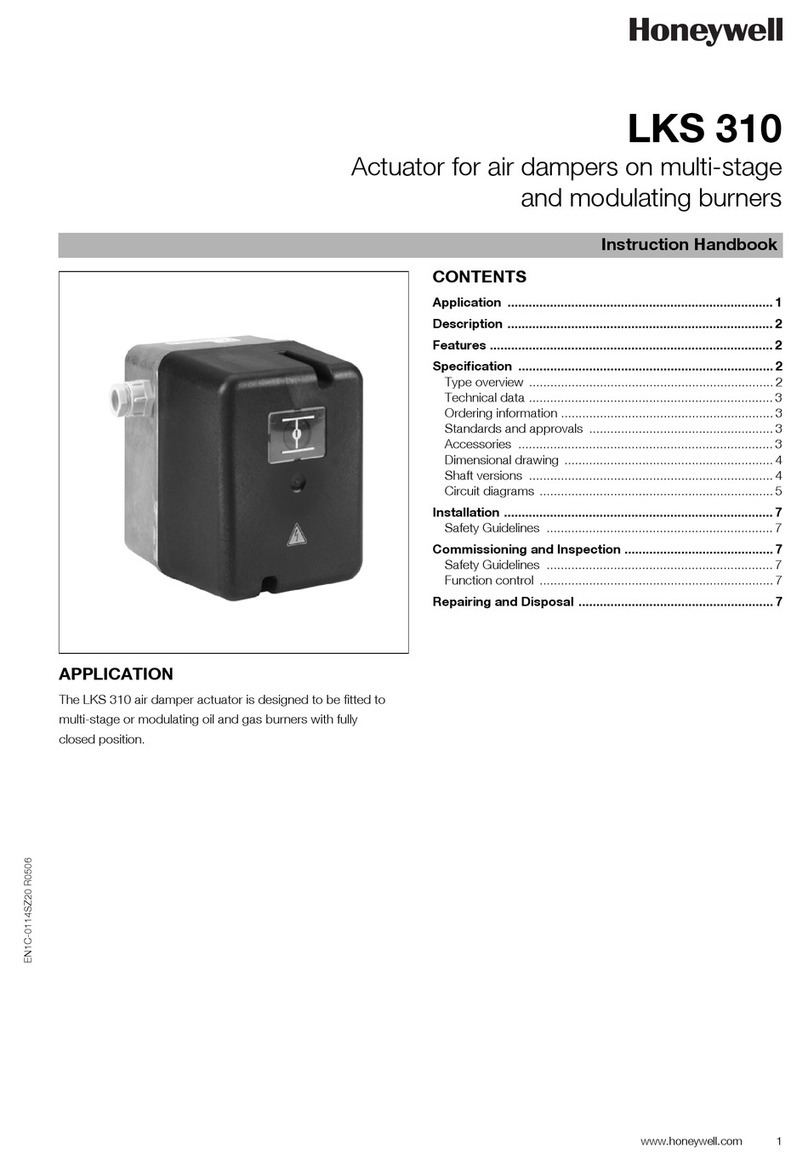
Honeywell
Honeywell LKS 310 Instruction handbook
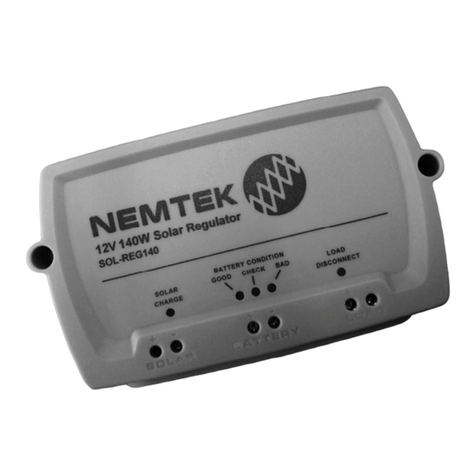
Nemtek
Nemtek SOL-REG140 user manual
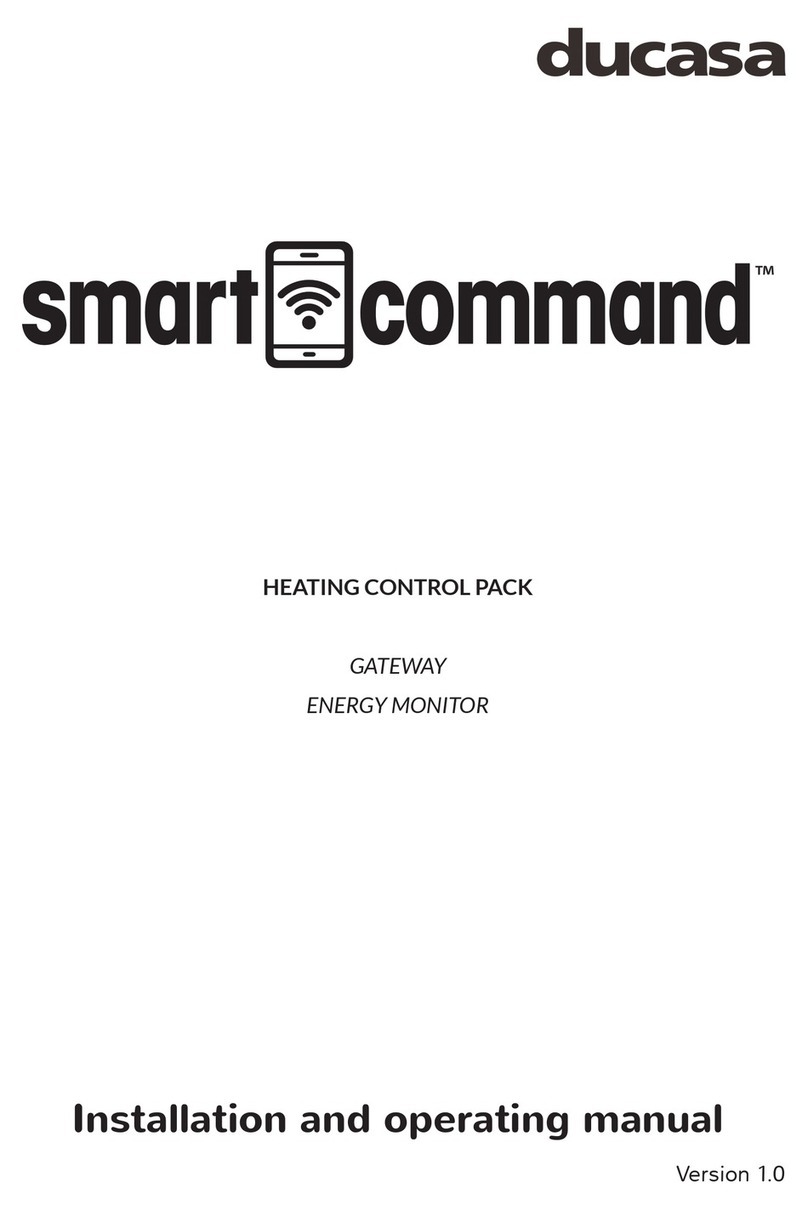
Ducasa
Ducasa Smart Command Installation and operating manual
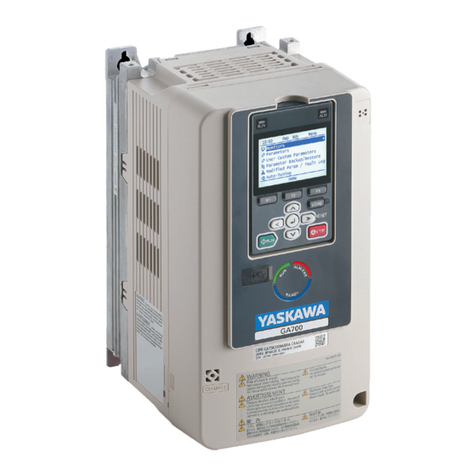
YASKAWA
YASKAWA CIPR-GA70C Series Initial Steps
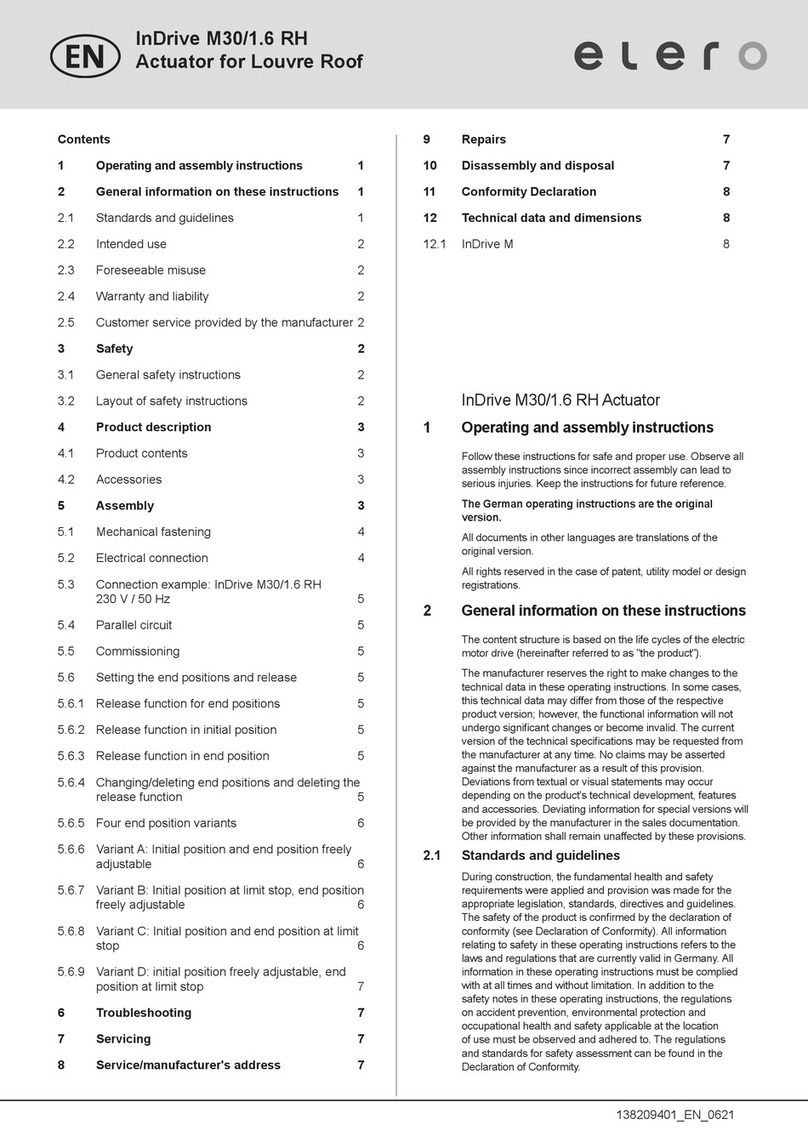
elero
elero InDrive M30/1.6 RH Operating and assembly instructions
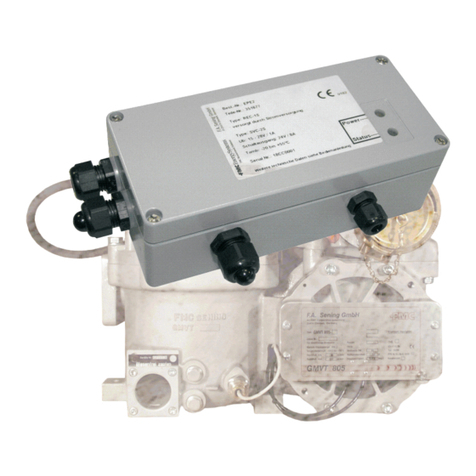
FMC Technologies
FMC Technologies Sening EPE2 installation manual

